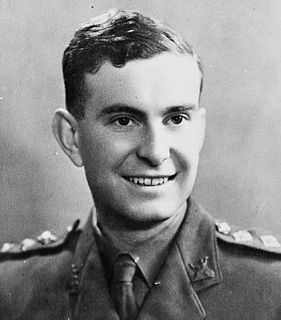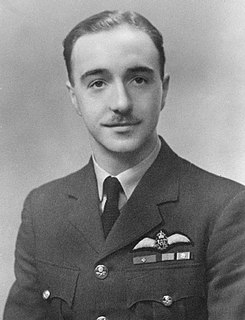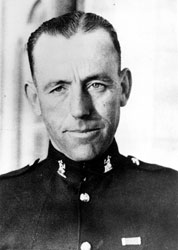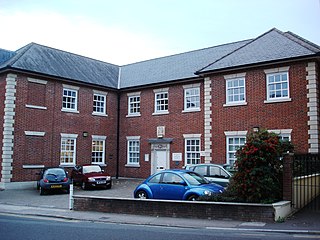
John Travers Cornwell VC, commonly known as Jack Cornwell or as Boy Cornwell, is remembered for his gallantry at the Battle of Jutland during Word War One. Having died at the age of only 16, he was posthumously awarded the Victoria Cross, the highest award for gallantry in the face of the enemy that can be awarded to British and Commonwealth forces. Cornwell is the third-youngest recipient of the VC after Andrew Fitzgibbon and Thomas Flinn.

William Edward Hall was the first Black person, first Nova Scotian, and third Canadian to receive the Victoria Cross. He received the medal for his actions in the Siege of Lucknow during the Indian Rebellion. Hall and an officer from his ship continued to load and fire a 24-pounder gun at the walls after the rest of the party had been killed or injured by the defenders.

John Niel Randle VC was a recipient of the Victoria Cross, the highest award for gallantry in the face of the enemy that can be awarded to British and Commonwealth forces.

William Reid VC was a Scottish recipient of the Victoria Cross, the highest and most prestigious award for gallantry in the face of the enemy that can be awarded to British and Commonwealth forces. He earned his Victoria Cross as a pilot in the Royal Air Force Bomber Command during the Second World War.
Captain Thomas James Young, VC was a Royal Navy officer and a recipient of the Victoria Cross, the highest award for gallantry in the face of the enemy that can be awarded to British and Commonwealth forces.
William Alfred Savage VC was an English recipient of the Victoria Cross, the highest and most prestigious award for gallantry in the face of the enemy that can be awarded to British and Commonwealth forces.

William Charles Williams VC was a British recipient of the Victoria Cross, the highest and most prestigious award for gallantry in the face of the enemy that can be awarded to British and Commonwealth forces.

George McKenzie Samson VC was a Scottish recipient of the Victoria Cross, the highest and most prestigious award for gallantry in the face of the enemy that can be awarded to British and Commonwealth forces, for his actions during the Gallipoli Campaign of the First World War. Samson was from Carnoustie in Angus, 26 years old, and a seaman in the Royal Naval Reserve when he was awarded the VC.
Ernest Seaman VC, MM was an English recipient of the Victoria Cross, the highest and most prestigious award for gallantry in the face of the enemy that can be awarded to British and Commonwealth forces. A soldier with The Royal Inniskilling Fusiliers, he was posthumously awarded the VC for his actions on 29 September 1918, during the Hundred Days Offensive of the First World War.

Maurice James Dease VC was a British Army officer during the First World War. He was one of the first British officer battle casualties of the war and the first posthumous recipient of the Victoria Cross in the war.

Lieutenant-Commander Gerard Broadmead Roope was a posthumous British recipient of the Victoria Cross, the highest and most prestigious award for gallantry in the face of the enemy awarded to British and Commonwealth forces.

Lieutenant Colonel Harold Marcus Ervine-Andrews, VC was a British Army officer and an Irish recipient of the Victoria Cross, the highest award for gallantry that can be awarded to British and Commonwealth forces, for his actions during the Second World War.

Joseph Henry Collin VC was an English recipient of the Victoria Cross, the highest and most prestigious award for gallantry in the face of the enemy that can be awarded to British and Commonwealth forces.

Commander Loftus William Jones VC was an English recipient of the Victoria Cross, the highest and most prestigious award for gallantry in the face of the enemy that can be awarded to British and Commonwealth forces.

Tom Fletcher Mayson VC was an English recipient of the Victoria Cross, the highest and most prestigious award for gallantry in the face of the enemy that can be awarded to British and Commonwealth forces.
William Odgers VC was a Royal Navy sailor and a recipient of the Victoria Cross, the highest award for gallantry in the face of the enemy that can be awarded to British and Commonwealth forces.

George Gristock VC was a British Army soldier and recipient of the Victoria Cross, the highest and most prestigious award for gallantry in the face of the enemy that can be awarded to British and Commonwealth forces.

Ernest Herbert Pitcher was an English recipient of the Victoria Cross (VC), the highest award for gallantry in the face of the enemy that can be awarded to British and Commonwealth forces.

Royal Naval Cemetery is a cemetery on the Isle of Portland, Dorset, England. The site overlooks Portland Harbour, and is found below the main entrance to the Verne Citadel. As the name suggests, the graveyard holds deceased servicemen and officers of Portland's Royal Navy which was stationed at the island until 1995. The cemetery holds 140 identified casualties in total to date, and is owned by the Ministry of Defence.





















